Adventure Education: Connecting Students with The Natural World
- By Vanessa Schutte
- March 1st, 2018
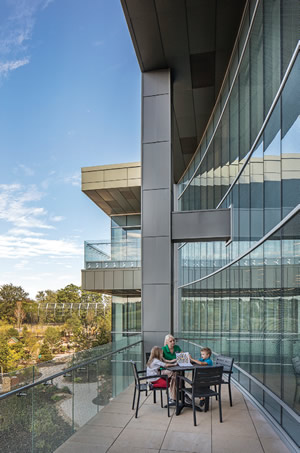
PHOTO © TOM KELLSER/COURTESY OF DLR GROUP
Kids are inherently curious creatures who learn by observing and interacting with their surroundings. They are intrinsically drawn to animals, watching carefully as animals play, relate, and move throughout nature. When a child’s educational experience includes daily interaction with animals, learning is elevated.
In Omaha, Neb., what started as a partnership between Omaha Public Schools, Papillion La Vista Community Schools, and the world-renowned Omaha Henry Doorly Zoo and Aquarium, has blossomed into a genuine learning environment that combines outdoor exploration with hands-on educational opportunities for local students. It is a place for students to connect with the natural world and enhance their understanding of and relationship with the animals and ecosystems around them. In simplest terms, it’s a school within a zoo.
Evolution of the Zoo Academy
“The Omaha Henry Doorly Zoo and Aquarium’s mission is to inspire, educate, and engage its millions of visitors to serve as life-long stewards for animals, their habitats, and their conservation. We’ve taken our mission one step further by providing unique science-related courses for students in the greater Omaha area,” said Dr. Elizabeth Mulkerrin, vice president of Education at the Omaha Henry Doorly Zoo and Aquarium.
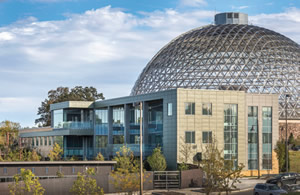
PHOTO © TOM KELLSER/COURTESY OF DLR GROUP
When the initial program launched in 1995, Omaha Public Schools provided a full-time biology instructor to teach zoology onsite at the zoo. In return, the zoo provided classroom space for the course. After 10 years, zoo staff and administrators from Omaha Public Schools and Papillion La Vista Community Schools enhanced the program to create a full-day Zoo Academy, which now features zoo-specific curriculum, internships at the zoo, and opportunities to conduct research projects.
The original zoology classroom, located in the basement of the Lied Jungle facility, provided a basic space for students to engage with the curriculum, but it was not conducive to Next-Generation learning. Building upon the success of the Zoo Academy, zoo and district officials determined a new facility was necessary to enhance the educational environment for students and enable them to expand the program to accommodate additional learners and age groups.
In 2014, DLR Group was commissioned to design the Robert B Daugherty Education Center, a 42,000-squarefoot facility that supports four distinct programs offering Science, Technology, Engineering, and Math (STEM) education.
Classrooms for Learning Today, Tomorrow, and Beyond
The new Education Center, which opened in 2017, features classrooms and labs, breakout spaces, huddle rooms, educator and zoo administration offices, and multipurpose spaces that connect learning with the natural surroundings of the zoo campus. It exemplifies the zoo’s education mission to enhance the public knowledge in all areas relating to the natural world and houses the following programs:
- The High School Zoo Academy is open to junior and senior students from Bellevue Public Schools, Omaha Public Schools, Papillion La Vista Community Schools, and Westside Community Schools. Students attend this school full-time and work alongside zoo staff, learning through hands-on care for animals.
- Students in the Middle School Zoo Academy are part of the Omaha Public Schools’ King Science and Technology Magnet and attend Zoology and Zoo Architecture classes two to three times per week. The entire Zoo is their classroom, which provides a unique experience unlike any other traditional middle school.
- Zoo Kindergarten is a partnership with the Zoo’s adopt-a-school, Bancroft Elementary School. The Kindergarten classrooms are next to the Bay Family Children’s Adventure Trails, an interactive exhibit that promotes learning through play in nature. Students in this program participate in walk-abouts on zoo grounds multiple times per week.
- Little Lions Preschool and Pre-K nurture children’s desire to explore and discover as they interact with the animals in their natural habitat in both half-day and full-day sessions. These students also participate in daily walkabouts on zoo grounds.
Space is limited to 220 students total, including 120 in the high school program. To be eligible for the high school, students must have completed their sophomore year and be on track for graduation, ensuring they have a basic understanding of science.
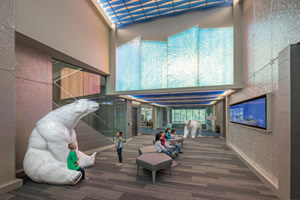
PHOTO © TOM KELLSER/COURTESY OF DLR GROUP
The application process includes a student essay, parent letter of support, teacher recommendations, and a panel interview.
“The kids really work hard to have the opportunity to come here. We don’t accept all applicants, so they truly want to be here just as much as I do, which is rewarding as a teacher,” says Pat Purkhiser, Science and Zoology teacher at the Zoo High School Academy.
Indoor/Outdoor Connections
Transparency and connectivity between the indoors and outdoors are the two main drivers behind DLR Group’s design. Traditional students experience what zoo officials call “nature deficiency,” meaning they learn solely in indoor environments without access to wildlife or conservation. DLR Group’s design successfully maximized exposure to nature and animals, by featuring organic connections between indoor and outdoor educational areas through massive windows, outdoor balconies, and open spaces.
Abundant windows fulfill two objectives: First, windows shape views to and from the learning environment; and second, they provide additional instructional opportunities. Because of the large number of windows, DLR Group designers researched the amount of frit that could safely be applied, while still protecting surrounding birds by eliminating potential bird strikes. The results are decorative window screens that feature 49 species native to Nebraska, offering a fun way to learn about local species while also redirecting birds from flying into panes of glass.
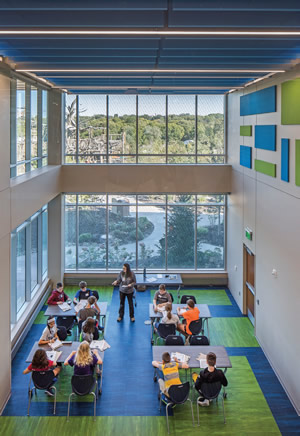
PHOTO © TOM KELLSER/COURTESY OF DLR GROUP
Zoo School. Can you imagine going to class at the zoo? That is an opportunity some students in the Omaha Public Schools district and Papillion La Vista Community Schools have available to them because of a program created by the world-renowned Omaha Henry Doorly Zoo and Aquarium in 1995. Now, 22 years later, a new Education Center features classrooms and labs, breakout spaces, huddle rooms, educator and zoo administration offices, and multipurpose spaces that connect learning with the natural surroundings of the zoo campus.
“The whole place has a modern, updated feel unlike other schools. I like the window glass design because the windows are unique and bird-safe,” says Aleyse, an 11th grader at the High School Zoo Academy.
In addition, a two-story curtain wall located near the front entrance puts learning on full display and gives visitors uninterrupted views from front entrance, through a multipurpose room, and out to the Bay Family Children’s Adventure Trails.
“Our design celebrates learning by allowing visitors and students to see in and see out,” said DLR Group Designer Mark Brim, AIA. “The Education Center is the backdrop to the Adventure Trails, where students learn through play. We successfully captured panoramic views to emphasize the activity and energy of the Trails.”
In one exhibit on the Adventure Trails, kids crawl through a bridge parallel to a secure area where squirrel monkeys are playing, giving kids the freedom to be creative and mimic the monkeys in their natural environment. In another exhibit, students crawl through tunnels with bubble skylights that allow students to safely be within inches of prairie dogs and observe their natural behaviors.
“This is not a traditional school environment in a good way. Everywhere is the classroom. This place gets kids excited about learning,” says Purkhiser.
Simulating Nature
Zoo officials and educators wanted the ability to simulate both daytime and nighttime conditions in a controlled interior space. The design team answered with a flexible, technology-rich multipurpose room that can be used for educational purposes, night camps, summer workshops, and group presentations. Electronic shades darken the room to enhance nighttime experience simulations, and retractable seating allows staff to reconfigure the room to accommodate a variety of activities. Preschool and young students use this space to simulate campfires and learn about nocturnal animals, while older students use the space for large lectures or group presentations.
“The multipurpose room is unlike any other multipurpose space in an educational facility. It’s fully-equipped with electronic shades, retractable seating, and a robust A/V system, affording students the opportunity to experience the kind of lifelike nature simulations they might not otherwise be able to observe,” says Brim.
A Treasure of Artifacts
DLR Group’s design also features a Zoology lab that is different from most traditional high school labs. Here, students handle thousands of artifacts and animal samples from around the world, including antlers, hooves, hides, and bug collections. These sacred objects are stored below ground in a secure vault when not being used, a space that is easily accessible via an adjacent elevator.
“The Zoology lab is my favorite. It’s set up so the kids can interact with the things they are learning about,” says Purkhiser. “It’s one thing to learn from a book, but when you can have it right in front of you, it’s that much better. They take responsibility for each of the animals in there and have to log everything they do. These types of responsibilities apply to the real world in a lot of ways.”
Students also have direct access from this lab to the zoo grounds where they observe the animals and participate in procedures and feedings with zoo professionals.
“The sequence of movement is seamless as students enter and exit zoo grounds from the Zoology lab in the Education Center. Students travel from the indoor instruction lab to the adjoining changing rooms, where they have direct access to zoo grounds,” says Brim.
Elevating Education for Nontraditional Learning
Students who attend the High School Zoo Academy have the ability to explore a variety of career pathways to determine their advanced course of study and future career choice. They participate in hands-on exercises with the animals and assist in research projects to create new and efficient ways to simulate natural habitats to benefit the health and well-being of the animals. Plus, they enjoy spending time with animals, which is a win-win for students and the zoo.
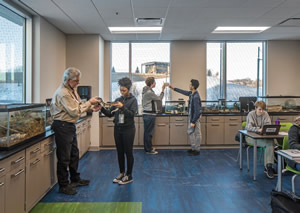
PHOTO © TOM KELLSER/COURTESY OF DLR GROUP
“Everything here is related to what I want to do in the future. I grew up with horses and want to go to college to become a large-animal veterinarian, so this is the perfect place for me to learn,” says Sierra, an 11th grader at the High School Zoo Academy. Aleyse adds, “I grew up on a farm and would like to work with exotic animals someday, so the Zoo Academy is a great fit for me.”
This nontraditional high school program approaches education from the student perspective. Teachers guide students through active scientific inquiries where they can apply STEM lessons to real-world practices. For instance, students in the Veterinary Science course make connections between their classroom learning and practical application by hands-on routine physicals with the animals. They hold and lift animals, listen to heartbeats, take temperatures, and monitor blood pressures while receiving feedback and instruction on best practices from zoo staff.
“The academy is very student-driven. We want the kids to get outside of their comfort zones in a good way. They come here knowing they’re technically going to school at a zoo, and we challenge them,” says Dr. Mulkerrin.
One recent project involved students developing a collecting tool that could move endangered Salt Creek tiger beetle larvae into separate incubation cylinders that increase the number of beetles surviving to adulthood. Together, academy students and zoo staff used engineering practices to successfully develop a “fishing tool” and the “larvae fishing technique,” which mimics the natural behavior of the beetle larvae and helps the larvae survive the moving process. Alongside zoo professionals, academy students applied the eight Next Generation Science Standard (NGSS) science and engineering practices by actively engaging in the research and development of the project, testing several different tools to determine the most successful moving technique. When the mature beetles were released into the wild, the tool and technique the Zoo Academy team developed resulted in a doubling of the population of the endangered species.
“It’s a really enjoyable school because you don’t actually feel like you’re at school, but you’re definitely learning,” says Aleyse.
The Education Center provides an avenue to rethink the educational environment and reinvent it in a nontraditional setting. It also gives these students a home base on a campus that comprises a 130-acre zoo. With 17,000 animals of 962 species at their fingertips, students are preparing themselves for STEM-related careers of the future, and having fun in the process.
This article originally appeared in the March 2018 issue of School Planning & Management.